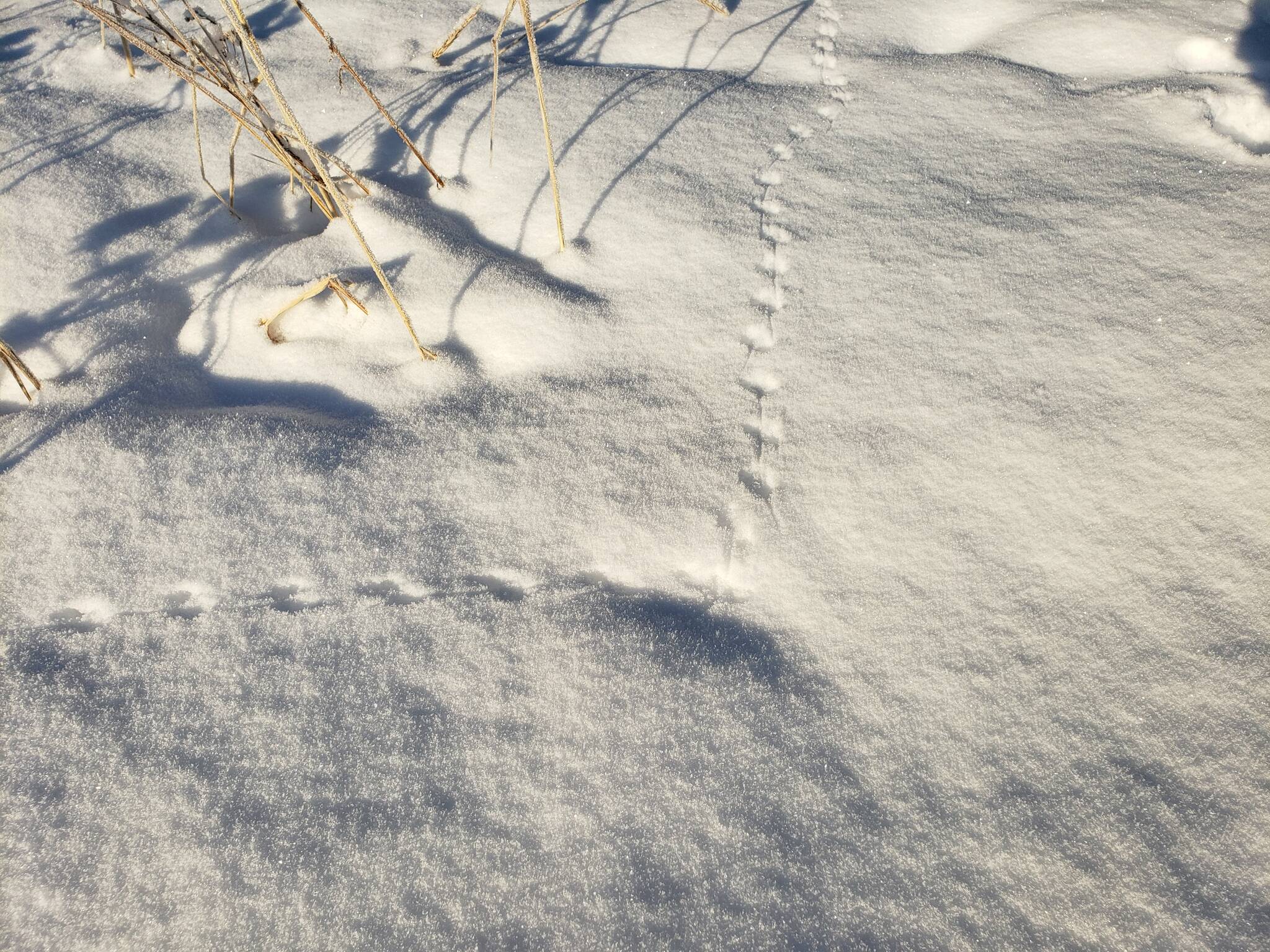By Mary F. Willson
The thermometer at my house read 11 degrees (Fahrenheit) after a clear, starry night; the sky looked clear, although the sun wasn’t really up yet. Juneau had recently enjoyed about 6 feet of lovely snow, but many of the trails had not yet been used much. In search of a well-packed trail, a friend and I headed for the Boy Scout Beach Trail.
All went smoothly until we reached the junction where the trail splits three ways, and none of the splits looked good. We chose to go right out onto the goose meadow and immediately found ourselves breaking trail and post-holing through deep, crusty wind-blown drifts. Even following in the footprints of my companion, I (weighing 40 pounds more) plunged and lunged, knee-deep and more. However, 100 yards or so farther on, walking became a pleasure again, because the low vegetation was almost clear of snow, thanks to the wind and some recent super-high tides that left a few scattered cakes of frozen foam.
Post-holing again out to the beach by the iconic cottonwood tree, we decided not to face the stiff, cold north wind that was churning up waters out in Lynn Canal. So, instead of coming back on the big, exposed beach, we turned toward the camp buildings, found a log, and had a little picnic in the sun. As soon as we got out our thermoses and lunch bags, two importunate ravens landed on the beach right in front of us — they knew the drill! Of course, we obliged them, tossing out bits of sandwich that they promptly snapped up. But they eyed a fragment of a sugar-snap pea with great suspicion and avoided going close to it—no veggies for them! One of them chose to sit next to us on the log for a while.
On this day in mid-December, the morning sun barely cleared the horizon. On the upper beach, I noticed that every isolated pebble cast a shadow much longer than itself, making a grid of conspicuous black stripes that called attention to each pebble.
The Chilkats across the canal were spectacular: the low morning sun made sharp contrasts between the sun-bright south-facing slopes and the intensely blue-shadowed north slopes. Behind us, the trees on the hillsides were individually defined by the snow they carried and on the peaks the snow delineated the minor topographical features very nicely.
Few critters were visible on this walk. A seal cruised by, just offshore, and gulls fossicked about in the tidal wrack. A wren zipped rapidly from trailside to shelter under some roots; they are so tiny, I wonder how they stay warm on frigid winter days. No midges or spiders crept on the snow surface. But there were tracks of mink along the river, red squirrels in the woods, ermine and vole at the edge of the meadow; one or two small birds (who?) had hopped and run in the beach rye lining the meadow trail. A low-flying raven (?) left the mark of one wing-tip in the loose surface snow.
The next day was mostly sunny and, again, very cold (7 degrees at my house in the morning). I opted for snowdrift-free walk on the dike trail. A few tracks of squirrels and maybe an ermine were the only natural history notes of the morning until I had almost finished the walk. And there in the stand of willows was a female pine grosbeak, busily nibbling buds. I frequently see these grosbeak in fall and winter, as they forage on high-bush cranberry, carefully extracting the seed and dropping the red fruit pulp—the opposite treatment from that of bohemian waxwings, who eat the fruit and excrete the seed.
A couple of days later, the cold remained (just six degrees here). I had an idea to try some of the lower meadows along the Eaglecrest Road, but roadside parking was hard to find and the thought of plowing through deep snow, even on snowshoes, was daunting. So, on up the road to the Lower Loop, nicely groomed and unoccupied. The sun couldn’t make it up over the peaks, but ‘shoeing was easy.
There was not a live critter in sight but there were plenty of signs of life. A porcupine was into long-distance travel, heading straight across the meadow, not stopping to forage. Ermine had cruised all over the meadows in circuitous routes, looking for a juicy morsel. Snowshoe hare tracks were abundant, mostly under sheltering conifer branches or going from one shelter to another. Grouse or ptarmigan had been active, inspecting salmonberry and blueberry bushes for tasty buds and sometimes staying long enough to trample the snow flat. Except for a few squirrel marks, the smaller folk had left no signs on the surface but were no doubt active below.
A day or two later, it was still very cold. A group of friends strolled the dike trail, enjoying the bright sunshine as the sun crept over the peaks. A dusting of fluffy snow lay atop a snow crust. Several voles (I think) had made sorties out into the grassy areas, circling back to the trees or to holes under grassy tussocks; we noted at least seven of these trackways, well separated from each other. Looking through the chain-link fence and across a ditch, we saw tracks on a big snow drift that looked like Two-toes—but how could a deer walk up that crusty snow on those thin legs, without punching through, when humans (on our side of the fence) generally ended up post-holing?
• Mary F. Willson is a retired professor of ecology. “On the Trails” appears every Wednesday in the Juneau Empire.

